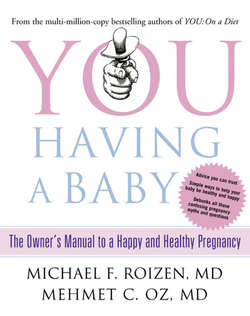Читать книгу You: Having a Baby: The Owner’s Manual to a Happy and Healthy Pregnancy - Michael Roizen F. - Страница 32
What’s Age Got to Do With It?
ОглавлениеWe all know plenty of people who have made the classic clock-ticking jokes about aging women who want kids. But what does that really mean? Before ovulation, eggs have two copies of each of the twenty-three chromosomes. They’re lined up waiting for the signal to divide for mom’s entire life. Unfortunately, the little spindles that pull chromosomes apart don’t work as well when they’ve been waiting for four decades. Instead of a clean break, two copies may be pulled to one side and none to the other. That’s what leads to an increased risk of chromosomal abnormalities such as Down syndrome and an increase in miscarriages in older moms.
Now, that doesn’t let pop totally off the hook. Older men’s (as in over 35) sperm have been linked to an increase in birth defects and autism, as well as an increased difficulty conceiving. New evidence even suggests that children born to older dads score lower on various brain tests through the age of seven.
While older parents may be better equipped to handle some aspects of pregnancy and child rearing (like some of the stresses and emotional wear and tear), and may be better able to support their children financially, there are some physiological trade-offs that you’ll want to consider if you are making a decision about when to have children.
until the release of the egg, and a signal then lets the sperm start the competitive swim up into the uterus.
While it’s by no means necessary to have an orgasm to get pregnant, women who orgasm between one minute before and forty-five minutes after their partner’s ejaculation have a higher tendency to retain sperm than those who don’t have an orgasm. On the man’s side, orgasm is required, because during orgasm fireworks in the brain cause involuntary contractions in lots of muscles in his body. Those contractions help him penetrate deeper and squeeze the prostate to eject sperm deep into the vagina.
Now, the actual fertilization process happens this way: After the egg drops from the ovary, it travels through the Fallopian tube, where there’s about a twenty-four-hour window when it can be fertilized. Since sperm live for up to a week in the cervix (they die after a few minutes of hitting the air), it’s not necessary for two people to have sex precisely when ovulation occurs, as many assume. In fact, conception is more likely to happen if sex occurs a couple days before the egg is released from the ovary. (See “Fertility Issues” on page 380 for more about getting the timing right.)
If all goes according to plan, the sperm meets the egg in the Fallopian tube, and the two half genomes unite to form a complete set of genes containing all the DNA necessary to make a new human being. The fertilized egg says thank you very much and moves along to the uterus. There it will attach to the uterine lining and begin the amazing process of becoming a baby.
